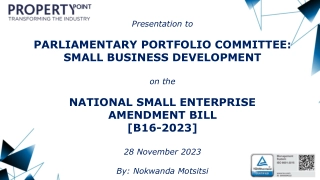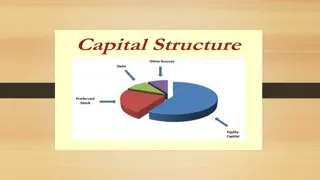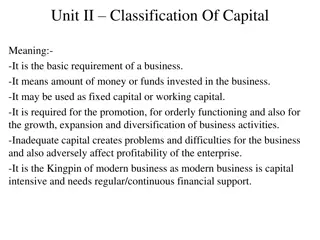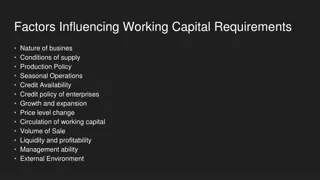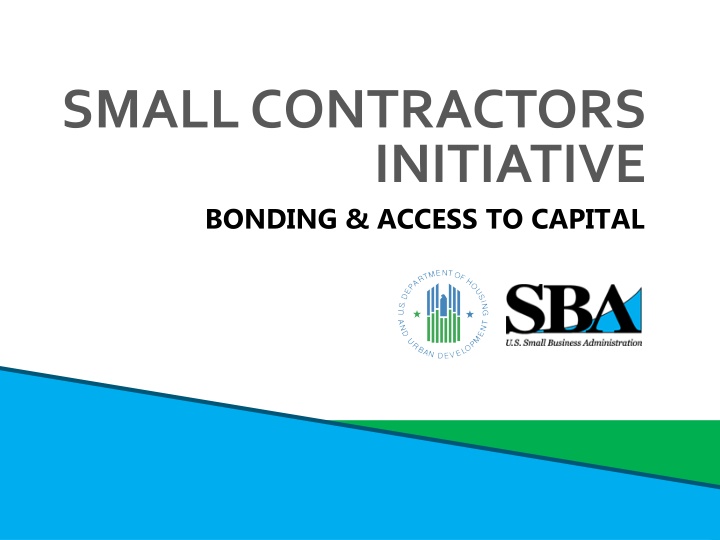
Working Capital for Small Contractors: Key Concepts & Strategies
Explore the importance of working capital for small contractors, learn about SBA bond guarantees, cash flow management, and loan application processes to ensure financial stability and growth in your business.
Download Presentation

Please find below an Image/Link to download the presentation.
The content on the website is provided AS IS for your information and personal use only. It may not be sold, licensed, or shared on other websites without obtaining consent from the author. If you encounter any issues during the download, it is possible that the publisher has removed the file from their server.
You are allowed to download the files provided on this website for personal or commercial use, subject to the condition that they are used lawfully. All files are the property of their respective owners.
The content on the website is provided AS IS for your information and personal use only. It may not be sold, licensed, or shared on other websites without obtaining consent from the author.
E N D
Presentation Transcript
SMALL CONTRACTORS INITIATIVE BONDING & ACCESS TO CAPITAL
SMALL CONTRACTORS INITIATIVE SESSION 5 WORKING CAPITAL AND LOAN APPLICATIONS
SESSION OVERVIEW PART B: LOAN APPLICATIONS Introduction and Learning Objectives Lender s View of Underwriting The Five C s of Business Assessment Character, Capacity, Capital, Collateral, Conditions Issues and Strengths Loan Types Select a Lender Readiness Checklist Additional Issues Loan Application Exercise Next Step Resources Introduction PART A: WORKING CAPITAL NEEDS What Is Working Capital? Definitions and Needs Cashflow Disbursement Management Projections Sources SBA Programs Next Steps and Resources U.S. Dept. of Housing and Urban Development U.S. Small Business Administration 3
INTRODUCTION SBA bond guarantees require sufficient working capital. Session helps firms determine working capital needs. This session is based on assumptions from Session 3: Business Planning. U.S. Dept. of Housing and Urban Development U.S. Small Business Administration 4
PART A: WORKING CAPITAL NEEDS U.S. Dept. of Housing and Urban Development U.S. Small Business Administration 5
PART A: LEARNING OBJECTIVES 1. Define working capital. 2. Understand that SBA bond guarantees require sufficient working capital and cashflow. 3. Use spreadsheets to project working capital needs. 4. Select one working capital loan source to approach. U.S. Dept. of Housing and Urban Development U.S. Small Business Administration 6
WHAT IS WORKING CAPITAL? The difference between current assets and current liabilities. (U.S. Small Business Administration) It is business capital that is used in day-to-day operations. U.S. Dept. of Housing and Urban Development U.S. Small Business Administration 7
NET WORKING CAPITAL CURRENT ASSETS Cash, marketable securities, accounts receivable, and stored materials. CURRENT LIABILITIES Trade credit, bank loans, and accrued short-term liabilities. NET WORKING CAPITAL Current assets less current liabilities. Both sides can be managed for success. U.S. Dept. of Housing and Urban Development U.S. Small Business Administration 8
WORKING CAPITAL REQUIREMENTS VARY OVER TIME Permanent vs. Project Funding Needs U.S. Dept. of Housing and Urban Development U.S. Small Business Administration 9
CASHFLOW PROJECTIONS PROJECT CASH FLOW PROJECTION U.S. Dept. of Housing and Urban Development U.S. Small Business Administration 10
DISBURSEMENT MANAGEMENT DELIVERY FLOAT Time between contractor installing a component and payment approval. PROCESSING FLOAT Delay between receipt of check by general contractor and its deposit in subcontractor s account. CLEARING FLOAT Delay between deposit of check and availability of funds. U.S. Dept. of Housing and Urban Development U.S. Small Business Administration 11
WORKING CAPITAL PROJECTIONS Review cashflow projection from your business plan. What is the largest negative? How much contingency should you add? How will you address this need? What percentage of the total WIP do you need? U.S. Dept. of Housing and Urban Development U.S. Small Business Administration 12
WORKING CAPITAL SOURCES Loans (bank, credit entities). Equity (stock/partnership/ownership). Factor cashflow. Funds control. Refinance long-term assets. Owner contributions. Reduce production to match funds. Trade credit. U.S. Dept. of Housing and Urban Development U.S. Small Business Administration 13
WHAT LENDERS WANT Current cashflow. Future contracts. Solid collateral. Guarantees, both personal and Government. Smooth growth patterns. U.S. Dept. of Housing and Urban Development U.S. Small Business Administration 14
SBA PROGRAMS TO INCREASE ASSETS 7(a) loan program. 504 hard assets. CAPLines. U.S. Dept. of Housing and Urban Development U.S. Small Business Administration 15
THE SBA 7(a) LOAN PROGRAM Assist new, growing small businesses. Business are often startups, projection-based, had a change of ownership, or have limited collateral or equity. Up to 90-percent financing. Weighted average term. Maximum funding up to $2 million. Must be owner-operated. Limited use for debt refinance. U.S. Dept. of Housing and Urban Development U.S. Small Business Administration 16
SBA 7(a) USE OF PROCEEDS U.S. Dept. of Housing and Urban Development U.S. Small Business Administration 17
SPECIAL 7(a) LOANS Contract loan program. Seasonal line of credit. Builder s line of credit. CAPLines. U.S. Dept. of Housing and Urban Development U.S. Small Business Administration 18
TYPICAL 504 STRUCTURE 504 LOAN 40% BANK LOAN 50% Total Project Costs $1,000,000 BORROWER 10% $500,000 10 Year Maturity Negotiable Rate $400,000 20 Year Fully Amortized Fixed Rate Bond Market $100,000 Borrower Contribution U.S. Dept. of Housing and Urban Development U.S. Small Business Administration 19
TYPICAL 504 STRUCTURE (cont.) 50 / 40 / 10 90% FINANCING 50 percent private sector loan 40 percent 504 loan 10 percent equity (*startup/special use*) Loan conditions: First lien position with a 50-percent loan-to-value ratio. 20-year fixed rate. Requires equity injection of 10 percent. U.S. Dept. of Housing and Urban Development U.S. Small Business Administration 20
ELIGIBLE 504 PROJECT COSTS Land and building acquisitions. New construction. Building renovations/ leasehold improvements. Major machinery and equipment with a minimum 10-year economic life. Related costs, which can include: Acquisition-related legal expenses. Bridge loan points and interest. Construction. contingency, up to 10 percent. Professional fees. Eligible soft costs. U.S. Dept. of Housing and Urban Development U.S. Small Business Administration 21
BUSINESS ELIGIBILITY For-Profit and privately held. Small. Net Worth less than $15.0 million. After-Tax income less than $5 million (2-year average). Creates or retains jobs.* Meets a public policy or community development goal of SBA. * One job per $65,000 in 504 loan dollars U.S. Dept. of Housing and Urban Development U.S. Small Business Administration 22
504 PROJECT STRUCTURE PURCHASE PRICE $1,000,000 APPRAISAL/ENVIRONMENTAL $4,500 INTERIM LOAN INTEREST $5,124 BANK FEE BRIDGE LOAN $4,100 TITLE INSURANCE (BRIDGE/504) $2,100 TRANSFER TAX $10,000 TOTAL ELIGIBLE PROJECT $1,025,824 BANK LOAN AT 50 PERCENT $512,912 SBA LOAN AT 40 PERCENT $410,330 EQUITY AT 10 PERCENT $102,582 U.S. Dept. of Housing and Urban Development U.S. Small Business Administration 23
UNDERWRITING CONSIDERATIONS CASHFLOW ANALYSIS DEC. 31, 2014 Proven management. Cashflow Coverage REVENUES $2,734 PRE-TAX EARNINGS $1,122 PLUS DEPRECIATION $16 PLUS INTEREST EXPENSE $0 PLUS RENT SAVINGS $169 Minimum 1:1 cashflow coverage based on historical operations or projections. Example of how to calculate cashflow coverage. PLUS OFFICERS COMPENSATION EXPENSE $249 CASHFLOW AVAILABLE $1,557 EXISTING DEBT SERVICE $21 PROPOSED DEBT SERVICE $308 OFFICERS COMP. NEEDED (40% PERSONAL D/I RATIO) $385 CASHFLOW NEEDED $714 CASHFLOW MARGIN $843 CASHFLOW COVERAGE 2.18 U.S. Dept. of Housing and Urban Development U.S. Small Business Administration 24
504 LENDING LIMITS Up to 40 percent of eligible 504 project costs: $1,500,000 maximum. $2,000,000 maximum for projects satisfying a public policy goal. $4,000,000 maximum for manufacturing. Creating (or retaining) job opportunities: $50,000 per job. $100,000 for manufacturing. U.S. Dept. of Housing and Urban Development U.S. Small Business Administration 25
SELF-EVALUATION Take 10 minutes to review the loan checklist: What does your firm have/need? How long will it take to develop? Who should be involved? Report top two items to develop. U.S. Dept. of Housing and Urban Development U.S. Small Business Administration 26
PART A: NEXT STEPS Loan application to be completed in this session. Participants list next steps in ongoing action plan. Quantify need in dollars. Identify sources. Research lender requirements. Draft applications. Self score: Would you invest? U.S. Dept. of Housing and Urban Development U.S. Small Business Administration 27
RESOURCES These attachments provide more information on Working capital: SBA 7(a) Term Loan Cashflow and Business Expansion Loan. Article: How Factoring Provides Access to Working Capital. U.S. Dept. of Housing and Urban Development U.S. Small Business Administration 28
PART B: LOAN APPLICATION U.S. Dept. of Housing and Urban Development U.S. Small Business Administration 29
PART B: INTRODUCTION To obtain working capital, firms must borrow funds from lenders. Firms must understand the lender s requirement to minimize risk. Borrower must demonstrate ability to repay. Participants will draft a loan application and list next steps to complete it after course. U.S. Dept. of Housing and Urban Development U.S. Small Business Administration 30
PART B: LEARNING OBJECTIVES 1. Understand application requirements and underwriting standards. 2. Identify and complete draft of loan application. U.S. Dept. of Housing and Urban Development U.S. Small Business Administration 31
UNDERWRITING: LENDERS VIEW Lenders want to minimize risk. On site, loan officer collects four forms: Balance sheet. Income statement. Cashflow analysis. Cross-check analysis (verification of the business viability other than the business owner). These measures ensure that lenders make quality loan-approval decisions. U.S. Dept. of Housing and Urban Development U.S. Small Business Administration 32
COMPONENTS OF THE BUSINESS ASSESSMENT: U.S. Dept. of Housing and Urban Development U.S. Small Business Administration 33
1. CHARACTER Assess the personal reputation of the business owner: Reputation and place in community. Residence legality. Type of dwelling (property, quality). Family general income. Family general expenses. Support for a loan and business by family members. Psychological and emotional stability. Entrepreneur s experience in business. Credit history (moneylenders, family, suppliers, relief fund). U.S. Dept. of Housing and Urban Development U.S. Small Business Administration 34
2. CAPACITY Assess the viability of the business: Business age. Regular suppliers strength. Volume of contracts. Number and status of workers. Procedure to provide services. Equipment necessary for efficient production. Average gross income or profit. Automation of management/accounting. U.S. Dept. of Housing and Urban Development U.S. Small Business Administration 35
3. CAPITAL Assess the liquid financial resources of the business: Client financial resources. Equity. Borrowed funds. Percentage of subcontracted work. Turnover by days (cycle of business activity). Volume of contracts. Frequency of draws. Accounts and reporting skill. U.S. Dept. of Housing and Urban Development U.S. Small Business Administration 36
4. COLLATERAL Assess the assets and guarantees available to pay loan: Title to assets. State and property reliability. Legal right to sell property. Realistic value of property. Psychological importance of a guarantee . Guarantor s ability to repay indebtedness. Borrower s and guarantor s motivation/willingness to repay indebtedness. U.S. Dept. of Housing and Urban Development U.S. Small Business Administration 37
5. CONDITIONS Conditions beyond business owner s control (e.g., seasonality, competitiveness, inflation, access to suppliers, abnormal weather). In order to assess the above conditions, you must: Understand the local economy. Research Government regulations affecting small businesses. Rank competitive advantages of the business. Account for specific loan conditions: Amount. Maturity. Amortization. U.S. Dept. of Housing and Urban Development U.S. Small Business Administration 38
POTENTIAL ISSUES Incomplete, inaccurate, or misleading information. Not considering business seasonality. Misunderstanding of family involvement in business. Inaccurate assessment of how loan will affect future business growth. Insufficient time and attention paid to how a client will use loan. U.S. Dept. of Housing and Urban Development U.S. Small Business Administration 39
EVALUATION OF STRENGTHS Business location/sales outlets. Business costs. Credit history/debts. Business type and its turnover/type of goods or services. Markup. Additional income sources. Legality/legal status. Competitiveness. Demand/seasonality. Owner s health status. Range of goods/business volume. General economic position of the business. Suppliers. U.S. Dept. of Housing and Urban Development U.S. Small Business Administration 40
LOAN TYPES SBA 7(a) 504 Bank loan Investor loan Equity loan Other U.S. Dept. of Housing and Urban Development U.S. Small Business Administration 41
SELECT A LENDER Who do you know now? Bank Credit union Broker U.S. Dept. of Housing and Urban Development U.S. Small Business Administration 42
READINESS CHECKLIST U.S. Dept. of Housing and Urban Development U.S. Small Business Administration 43
ADDITIONAL ISSUES Questions from attorney, CPA, insurance carrier. Title insurance issues. Life insurance/assignment. Organizational documents. Construction/subcontractors lien waivers. Personal history (Form 912). Other contracts. Note: Address any special circumstance early. U.S. Dept. of Housing and Urban Development U.S. Small Business Administration 44
LOAN APPLICATION EXERCISE Select a loan source. Take 20 minutes to: Review application form. What information is difficult to provide? How will your firm respond? U.S. Dept. of Housing and Urban Development U.S. Small Business Administration 45
PART B: NEXT STEPS Each participating contractor undertakes preparation of real loan application: Complete drafts of all sections, to the extent possible. Identify incomplete elements in action plan to finish and submit loan application. Review list with facilitator to see whether any updates or revisions are needed. U.S. Dept. of Housing and Urban Development U.S. Small Business Administration 46

